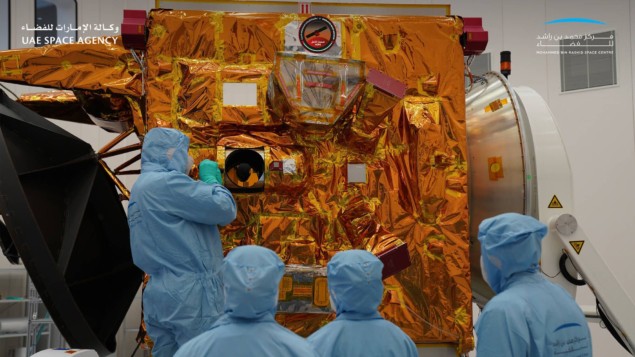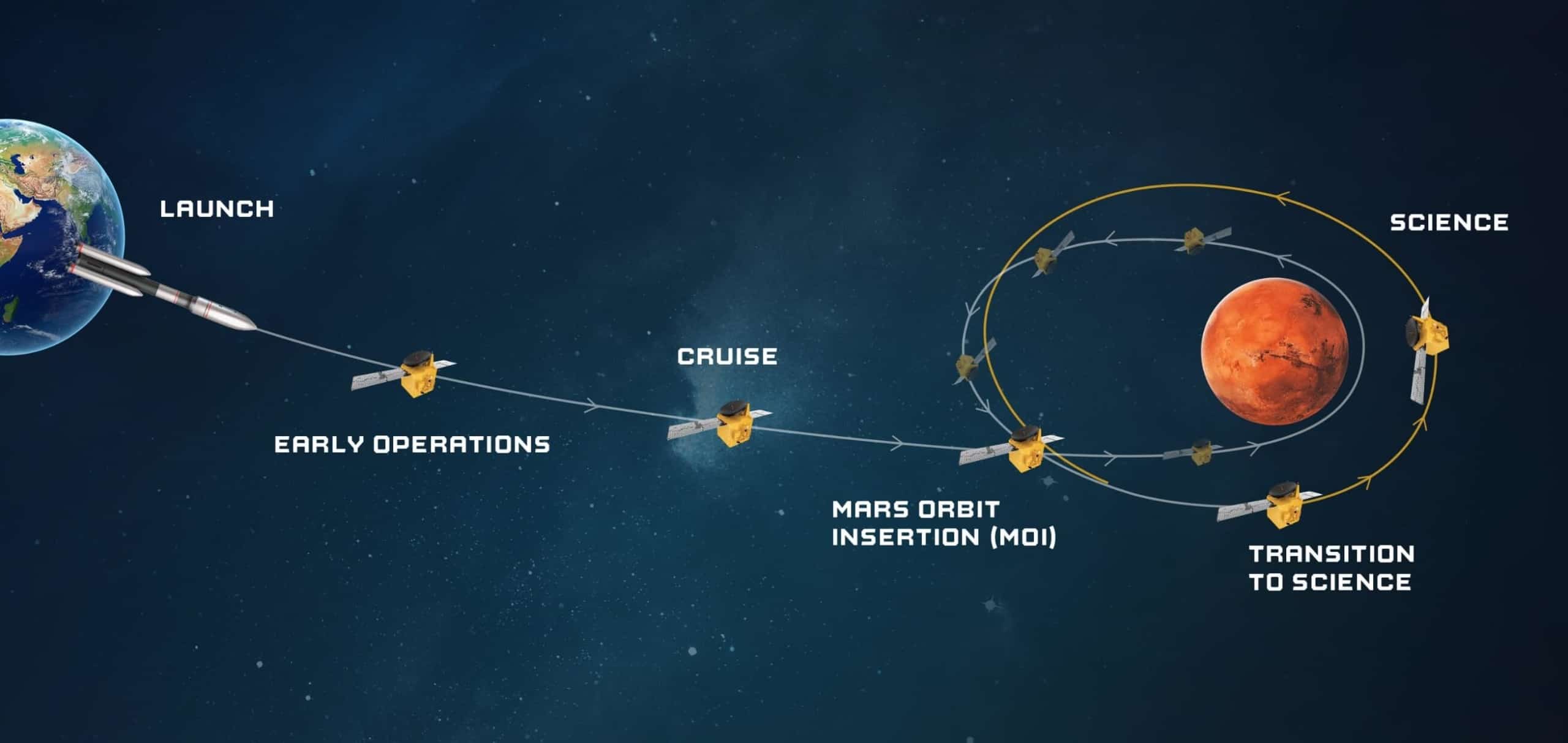
The $200m Emirates Mars Mission successfully arrived in Martian orbit today, concluding its seven-month journey to the red planet. The arrival of the United Arab Emirates’ (UAE) probe – named Hope – marks the beginning of the science stage in the first interplanetary voyage undertaken by an Arab nation.
At 16:13 GMT, mission control at Dubai’s Mohammed bin Rashid Space Centre (MBRSC) received a signal, relayed from Nasa’s Deep Space Network, to confirm that the car-sized spacecraft had entered into a stable orbit. That followed a nail-biting half hour as Hope fired its Delta V thrusters, slowing its speed from over 121,000 km/h to approximately 18,000 km/h to be captured by Mars’ gravity. The 1500 kg craft will now undergo further manoeuvres and testing during the coming weeks before it begins returning science data from the Martian atmosphere.
“We congratulate our leadership and our people of all nationalities in the UAE,” said Sarah Al Amiri, chair of the UAE Space Agency via Twitter. “The science team has a lot of work to do, and we are all confident that they will make new, great, and tremendous discoveries about the red planet.”
Hope is the first of three separate missions arriving at Mars this month and will be swiftly followed by China’s Tianwen-1 spacecraft, which arrives in orbit on 10 February ahead of landing a rover in May. Then, on 18 February NASA’s Perseverance rover will land and begin searching for signs of ancient life in a Martian crater that was once flooded with water.

Weather watcher
Hope’s main scientific objective is to study daily and seasonal weather changes, as well as observing how hydrogen and oxygen are lost into space. This data could help us better understand how Mars turned into the dusty barren planet we see today. Hope carries three main instruments: two spectrometers – one operating in the infrared and the other in ultraviolet – and an imager that will study the lower atmosphere at visible and ultraviolet wavelengths.
Sending a mission to Mars was a bold statement from the UAE, an Arabian state with a population of 9.8 million that gained independence from the UK in 1971. Today’s achievement comes just three years since Hazza al-Mansouri became the first Emirati in space when he spent eight days on the International Space Station.
The UAE could have easily just purchased a spacecraft to go to Mars, but they had a goal to build it, not buy it
Brett Landin
Having established a national space agency in 2014, the UAE quickly built up its space capacity by collaborating with established space nations. Launched from Japan’s Tanegashima Space Center in July, the Hope spacecraft was built in partnership with the Laboratory for Atmospheric and Space Physics (LASP) at the University of Colorado, Boulder. The mission team comprises 200 staff from MBRSC, 150 from LASP, along with support from an international science team and roughly 100 partners.
“The UAE could have easily just purchased a spacecraft to go to Mars, but they had a goal to build it, not buy it,” says LASP engineer Brett Landin, who leads the mission’s spacecraft team. “I think the most fascinating part of this mission has been watching a nation decide to institute a meaningful change and then actually make it happen in a very short period of time.”
Building a ‘knowledge economy’
It may still be early days, but the UAE has grand ambitions for space exploration. Hope is just one project in the nation’s “Mars 2117” programme, which has the ultimate goal of establishing the first human settlement on Mars within the next century. Other key projects are to send an unmanned rover, dubbed Rashid, to the Moon in 2024 and to build a “Mars Science City” in the desert outside of Dubai – a research facility that will eventually host analogue “missions to Mars”.

The long road to Mars
By investing heavily in space exploration, the UAE hopes to kickstart its science and engineering sectors, to diversify its economy away from oil. Since the Hope mission was first mooted in 2014, mission leaders have spoken regularly about how it can foster interest in science among students. Under broader plans outlined in 2017, the UAE set the target that “knowledge workers” would make up 40% of its total workforce by the end of 2021.
“The UAE’s Mars Mission is a clear reflection of the UAE’s vision and ambition,” says Sanam Vakil, a Middle East researcher at Chatham House, an independent policy institute in the UK. “The project is designed to promote the knowledge-based economy while also inspiring Emiratis and attract other regional nationals to the Emirati economic model.”



